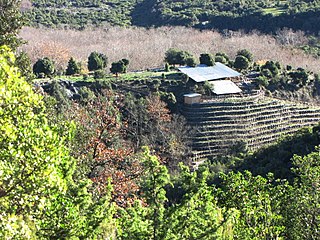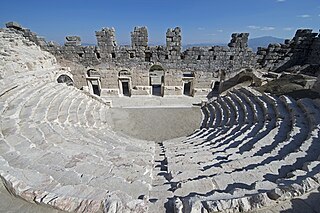
Stobi or Stoboi, was an ancient town of Paeonia, later conquered by Macedon, and finally turned into the capital of the Roman province of Macedonia Salutaris. It is located near Gradsko, North Macedonia, on the main road that leads from the Danube to the Aegean Sea and is considered by many to be the most famous archaeological site in North Macedonia. Stobi was built where the Erigon joins the Axios (Vardar), making it strategically important as a center for both trade and warfare.

Dion is a village and municipal unit in the municipality of Dion-Olympos in the Pieria regional unit, Greece. It is located at the foot of Mount Olympus at a distance of 17 km from the capital city of Katerini.

Hispellum was an ancient town of Umbria, Italy, 6 km (3.7 mi) north of Fulginiae on the road to Perusia.

Gramos is a remote mountain village and a former municipality in Kastoria regional unit, Macedonia, Greece. Since the 2011 local government reform it is part of the Nestorio municipality as a municipal unit. The municipal unit has an area of 59.422 km2. Population 18 (2011). The village is a traditional Aromanian (Vlach) settlement, named after the nearby Gramos mountains to its south. It lies very close to the Albanian border. The source of the river Aliakmonas is near Gramos. It had the smallest population of any municipality in Greece at 28 inhabitants in the 2001 Greek census. It was also the least densely populated community or municipality in Greece, at 0.47 inhabitants/km2. A small road connects Gramos with Nestorio, 20 km to its east. Gramos is the nearest village to Lake Gkistova.

Tsotyli is a village and a former municipality, currently part of the Voio municipality. Prior to 2011 local government reforms it was the seat of the municipality of Tsotyli. The municipal unit has an area of 330.269 km2, the community 25.658 km2. The 2021 census recorded 1,453 residents in the village and 2,619 residents in the municipal unit of Tsotyli. It is a famous western Greek area, notable for its ancient housing estate (oikotrofeio). The Archeological Museum of Tsotili is another significant feature of the area.

The Puente de Boyacá is a small bridge located at the Pan-American Highway, 110 km east of Bogotá and 14 km west from Tunja in a valley, crossing Teatinos River. Several monuments have been erected in the surroundings to commemorate the historic battle of August 7, 1819, known as the Battle of Boyacá, which granted independence to New Granada.

Voio is a mountain range in the southwestern Kastoria and western Kozani regional units in Macedonia, Greece. The mountain is part of the Pindus mountains. Its highest elevation is 1,805 m. It is a densely forested and sparsely populated mountain range. It is drained towards the river Sarantaporos in the west and towards the Aliakmonas in the east. The nearest mountain ranges are Gramos to the west and Smolikas to the southwest.

Leibethra or Libethra, in the modern pronunciation Leivithra was an ancient Macedonian city at the foot of Mount Olympus, near the present settlement of Skotina. Archaeologists have discovered tombs there from the late Bronze Age containing rich burial objects. Leivithra played a remarkable role in the history of Pieria.

The Archaeological Museum of Dion is a museum in Dion in the Pieria regional unit of Central Macedonia, Greece.

Prusias ad Hypium was a city in ancient Bithynia, and afterwards in the late Roman province of Honorias. In the 4th century it became a bishopric that was a suffragan of Claudiopolis in Honoriade. Before its conquest by King Prusias I of Bithynia, it was named Cierus or Kieros and belonged to the Heraclea Pontica. Photius writes that it was called Kieros, after the river which flows by it.

Early Byzantine mosaics in the Middle East are a group of Christian mosaics created between the 4th and the 8th centuries in ancient Syria, Palestine and Egypt when the area belonged to the Byzantine Empire. The eastern provinces of the Eastern Roman Empire and its continuation, the Byzantine Empire, inherited a strong artistic tradition from pagan Late Antiquity. The tradition of making mosaics was carried on in the Umayyad era until the end of the 8th century. The great majority of these works of art were later destroyed but archeological excavations unearthed many surviving examples.
Krimini is a village located in the Voio municipality, situated in Kozani regional unit, in the Western Macedonia region of Greece. The village of Rodochori is nearby.
Liknades is a village located in the Voio municipality, situated in western Kozani regional unit, in the Greek region of Western Macedonia. The village is 75 kilometers east of the town of Kozani.
Chrysavgi is a mountain village in the municipality of Voio, West Macedonia, Greece. Only 30 minutes from Grevena and 20 minutes from Tsotyli, it is built with traditional architecture at an altitude of 860 meters. The stone houses give a special and impressive picture.

Pelekanos is a small village in the municipality of Voio, West Macedonia periphery, Greece. With a population of around 269 (2011), mostly elderly, residents it is set at the foothills (760m) of Mount Askio. The Byzantine historian Procopius mentions the location as Justinian I's fortress of "Pelekon". Ruins of the fortress can be found in the surrounding area to this day. During the early 20th century, the region became relatively poor and economically isolated and consequently a significant part of its population emigrated abroad. Nowadays, the village is well-connected through a modern highway and is known for its red wine production and also as the filming location of Glory Sky which officially represented Greece in the 1963 Cannes Film Festival.

Umm Qais or Qays is a town in northern Jordan principally known for its proximity to the ruins of the ancient Gadara. It is the largest city in the Bani Kinanah Department and Irbid Governorate in the extreme northwest of the country, near Jordan's borders with Israel and Syria. Today, the site is divided into three main areas: the archaeological site (Gadara), the traditional village, and the modern town of Umm Qais.
Vythos is a village in Kozani regional unit, West Macedonia, Greece. Since the 2011 local government reform it is part of the municipality Voio, of which it is a member of the municipality unit of Pentalofos. Βυθὀς means seabed, which is a paradoxical name for a village typified by its mountainous terrain and high altitude.

Cibyra or Kibyra, also referred to as Cibyra Magna, was an Ancient Greek city near the modern town of Gölhisar, in Burdur Province. It lay outside the north-western limits of the ancient province of Lycia and was the chief city of an independent state known as Cibyratis. Since 2016 it has been included in the Tentative list of World Heritage Sites in Turkey.

Paphos Archaeological Park contains the major part of the important ancient Greek and Roman city and is located in Paphos, southwest Cyprus. The park, still under excavation, is within the Nea Pafos section of the coastal city.

The Archaeological Park of Dion is the most important archaeological site at Mount Olympus in Greece, located in Dion. In the area comprised by the Archaeological Park of Dion, sanctuaries were found from the Hellenistic and Roman periods. The park displays the importance of ancient Dion in the history of Pieria.















